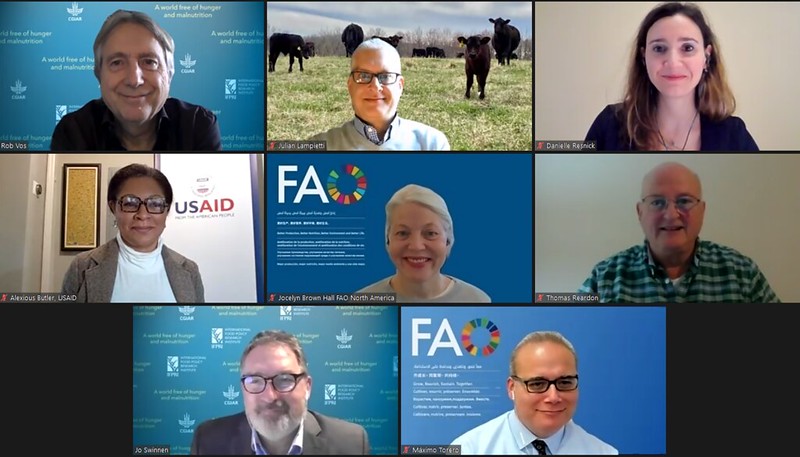Over the last few years, global food systems have been disrupted by conflict, economic shocks, climate change, and the COVID-19 pandemic, increasing global food insecurity and malnutrition.
A Jan. 19 policy seminar examined the implications of fragile agrifood systems and the findings of FAO’s The State of Food and Agriculture 2021 (SOFA) report. The report analyzes the vulnerabilities of food supply chains and how at-risk populations such as those in rural areas cope with risks and shocks.
Moderator Rob Vos, Director of IFPRI’s Markets, Trade, and Institutions Division, emphasized the report’s focus on diversification in building resilience across all relevant sectors and layers of government institutions to improve every country’s capacity to absorb shocks and stresses.
“The report is a timely response to the UN Food Systems Summit, which calls for making food systems’ resilience and vulnerability, shocks, and stresses one of the five central objectives for well-functioning and healthy agrifood systems,” said IFPRI Director General Johan Swinnen, underscoring the food systems approach of the SOFA report.
The SOFA report defines agrifood system resilience and provides a framework for analyzing it using a suite of indicators for more than 140 countries. It also lays out guiding principles for building more resilient agrifood systems, advising countries to prepare for disruptions using a system-wide, multi-risk, multi-actor and multi-sectoral approach. Of the five resilience capacities—preventive, anticipate, absorb, adapt and transform—the report focuses on the third, the capacity of the agrifood systems to absorb shocks and stresses and bounce back.
FAO Chief Economist Máximo Torero explained the report’s four indicators of absorptive capacity:
- The absorptive capacity of a country’s primary agricultural sector, measured by the primary production flexibility index (PPFI), based on commodity diversity and markets.
- The country’s food supply, measured by the dietary sourcing flexibility index (DSFI).
- A robust transport network, an essential ingredient for resilient and guarantees physical access to food at local level.
- Economic access to healthy diets, especially in times of a crisis.
The continuous functioning of food supply chains is essential to ensure stable and sustainable food flow for all. This can be achieved by making food supply chains more resilient. “Diverse and well-connected food supply chains enhance agrifood systems’ resilience by providing multiple pathways for producing, sourcing and distributing food,” Torero said.
Another important recommendation in the SOFA report is to “focus on details,” stressed World Bank Global Agriculture Practice Manager Julian Lampietti—that is, to look at horizontal and vertical supply chain at both the local- and country-level to foster resilience. While diversified food systems help vulnerable rural households, they only work if markets are open and transparent. Fostering healthy competition in supply chains without saturating the market is therefore important, he explained.
The main drivers of building household resilience for rural and other vulnerable populations are access to education, access to basic services such as clean water, and asset ownership, and interventions are especially key to households comprising women. For example, the U.S. Agency for International Development (USAID) has invested $400 million over eight years in partnerships in Kenya to foster resilience and economic growth by strengthening governance systems, disaster risk financing and private sector capital, said USAID Acting Deputy Assistant Administrator in the Bureau for Resilience and Food Security Alexious Butler. In addition, the agency’s complementary investments in Kenya’s road infrastructure connected northern arid livestock markets to the Nairobi market where the demand for meat was higher. These investments through various partnerships helped build local markets and supported 700,000 people in building assets, increasing their ability to weather chronic shocks and stresses.
Since the start of the pandemic, agrifood supply chains have shown resilience and innovative capacity to adapt and circumvent disruptions. Vulnerabilities remain, but farmers and private businesses have shown tremendous adaptive capacity. Yet many small players were hurt economically due to short-term government lockdown decisions classifying certain businesses as essential and others non-essential. Many third-party enterprises—middlemen in supply chains—fell into the latter category, strangling the movement of food supplies in some places. For instance, Nigeria declared third-party enterprises non-essential; yet out of 75% of the maize consumed in Nigeria, 35% is moved by third party logistics. This hampered maize supply chains in a country where maize is a staple food crop, said Thomas Reardon, a Professor in the Michigan State University Department of Agricultural, Food, and Resource Economics.
Comparing the food system to the human body, Reardon said that pandemic resilience was strongest where the “blood”—wholesalers and logistics firms-–and “bones”—transportation and markets—were functioning well. “Investment in ‘bones’ and in a business environment that allows pivoting and flexibility is crucial for resilience, diversification, and dynamism,” he added.
“Pathways to achieving resilient food systems rest on governments making policy trade-offs,” said Brookings Institution Fellow Danielle Resnick (also an IFPRI Non-Resident Fellow). While the report considers known and unknown climate, health, and economic risks to building resilient agrifood system policies, she said, political risks such as party polarization and geopolitical tensions also play a role. Policymakers should weigh these factors to address possible tradeoffs and to mediate between different interests.
Integration of agricultural supply chains with the transportation and infrastructure sectors— nationally, regionally and internationally—is vital to the well-being of agricultural sector, said FAO North America Director Jocelyn Brown Hall. “No single sector touches any other sector as much as agriculture and food security,” Hall said, and so broader policy decisions must consider these elements and be made in an inclusive and sustainable manner.
Swati Malhotra is a Communications Specialist with IFPRI’s Markets, Trade, and Institutions Division.







